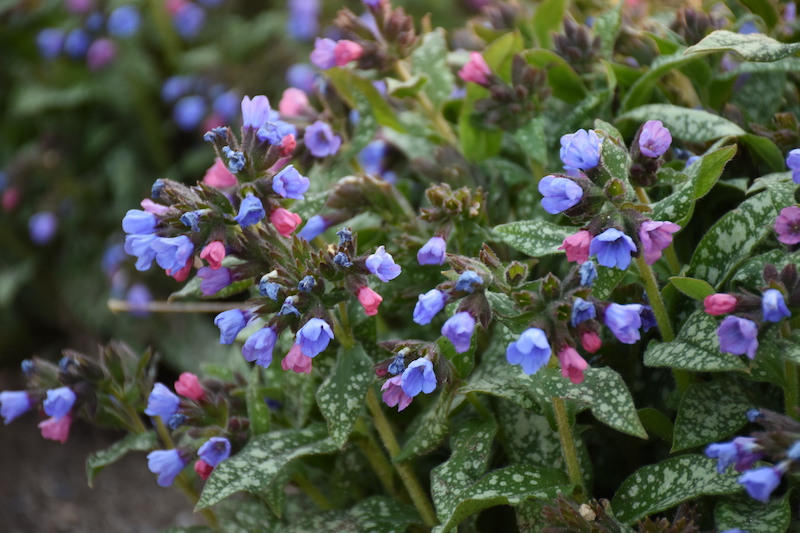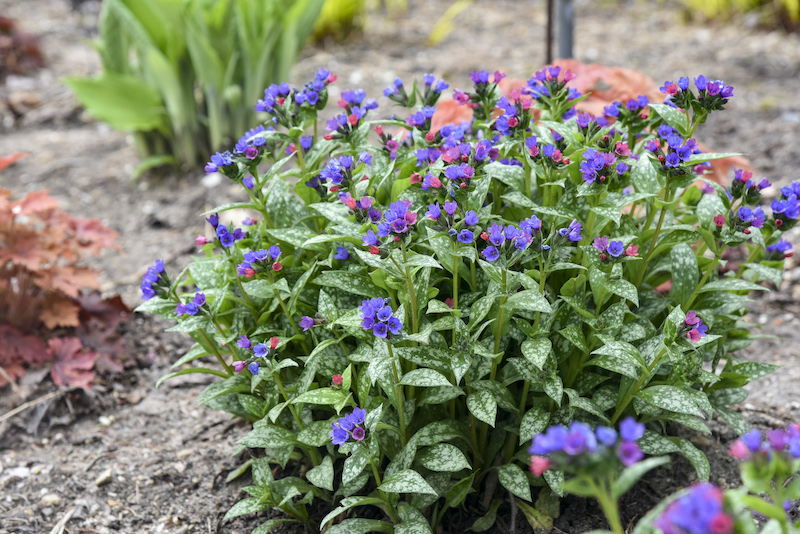Growing Lungwort
Despite the off-putting name, lungwort is a stunning semi-evergreen perennial. Its botanical genus is Pulmonaria, originating from the latin pulmo, which means lung. The name comes from the lung-shaped spotted foliage.
Blooms appear in early spring and can last until first frost. This fascinating, low-growing plant has fuzzy speckled leaves and variegated flowers that can be deep pink, violet, or blue. Flower stalks can reach 18 inches tall, propping up the bell-shaped blooms.
Lungwort grows well in USDA hardiness zones 3-8. The mature size of a lungwort plant is 6-12 inches tall, and 12-18 inches wide.

Planting Lungwort
During the late spring or summer, plant your lungwort in a shady spot that gets a few hours of dappled morning sunlight. These plants prefer moist, humus-rich soil and tolerate clay-based soils. The soil should be nutrient rich with a neutral to alkaline pH. To make acidic soil more neutral to alkaline, blend in agricultural lime.
Make sure to provide lungwort with plenty of water. Adequate moisture and shade are most important for growing healthy lungwort plants. Harsh hot summer sun can quickly wilt these plants. Lungwort does best when grown with taller plants that can provide shade. Top-dress the soil with a layer of mulch to retain soil moisture and boost the organic content of the soil.
Watering Lungwort
Lungworts originate from cool shady areas in Europe and western Asia. They have moderate water requirements and prefer not to dry out. The soil should remain on the moist side, but never soggy. Sitting in water for an extended time can cause disease issues for these plants. Water when the surrounding soil is dry, or if you see signs of wilting. Applying a one-inch-thick layer of mulch to the surrounding soil will help to keep the soil moist and keep weeds at bay.

Fertilizing Lungwort
At the beginning of the growing season, you should fertilize your lungwort. Sprinkle a granular, slow-release fertilizer around the root zone. Apply compost annually to amend the soil as necessary. Heavy fertilization is not recommended. Typically, lungwort is satisfied with native soil, water, and some shade. This plant can be sensitive to soil pH fluctuations that may occur with too much food.
Pruning Lungwort
At the end of fall, you should prune back your lungwort plants as the foliage starts to fade and turn brown. In warmer climates, lungwort stays semi-evergreen and can be cut back in early spring before new growth begins. Remove flower stalks as the flowers finish blooming throughout the growing season. This will encourage new healthy growth. Remove dead or diseased parts of the plant as needed.
Extend the short lifespan of lungwort by dividing the plant every 3 to 5 years. In the early fall, dig up the entire plant and root ball, and divide the clump into sections with a proportionate root mass.
Caring For Lungwort in Pots
These plants require extra care in containers. Lungwort needs frequent watering and can dry out faster in containers. Some potting soils will not be appropriate for lungwort as they contain too much peat, which lowers the soil pH level. Lungwort performs best in a shady area of the garden. Move the pots out of the sun when necessary to avoid wilting. These plants grow quickly and have a dense root system, so they should be repotted annually to provide space for the roots to expand.

Winter Care for Lungwort
Lungwort is low maintenance and is able to survive a harsh winter. Lungwort grows well in USDA hardiness zones 3 and 4. For best results, these plants should be mulched before winter in order to insulate the root system and crown. With a two-inch layer of mulch, the roots will experience less stress from frost heaves. After the last frost, remove the mulch from the top of the plant, allowing new growth to emerge. If you have potted your lungwort, you can leave it outside in a covered area.
 |
Author Chris Link - Published 3-3-2023 |
